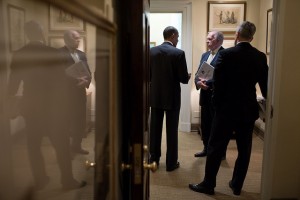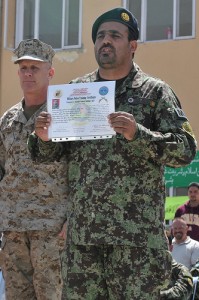At the core of the expanding dragnet approved in secret by the FISA Court, Eric Lichtblau explained, is the application of “special needs” to “track” terrorists.
In one of the court’s most important decisions, the judges have expanded the use in terrorism cases of a legal principle known as the “special needs” doctrine and carved out an exception to the Fourth Amendment’s requirement of a warrant for searches and seizures, the officials said.
The special needs doctrine was originally established in 1989 by the Supreme Court in a ruling allowing the drug testing of railway workers, finding that a minimal intrusion on privacy was justified by the government’s need to combat an overriding public danger. Applying that concept more broadly, the FISA judges have ruled that the N.S.A.’s collection and examination of Americans’ communications data to track possible terrorists does not run afoul of the Fourth Amendment, the officials said.
That legal interpretation is significant, several outside legal experts said, because it uses a relatively narrow area of the law — used to justify airport screenings, for instance, or drunken-driving checkpoints — and applies it much more broadly, in secret, to the wholesale collection of communications in pursuit of terrorism suspects. “It seems like a legal stretch,” William C. Banks, a national security law expert at Syracuse University, said in response to a description of the decision. [my emphasis]
That’s actually not entirely secret. We see the beginnings of the process in the 2002 In Re Sealed Case decision by the FISC Court of Review, which thwarted FISA Court Chief Judge Royce Lamberth’s attempt to limit how much FISA information got shared for criminal prosecutions. In approving the “significant purpose” language passed in the PATRIOT Act which made it far easier for the government to use FISA information to justify criminal investigations, the decision pointed to the post-9/11 threat of terrorism to justify FISA as a special needs program (though as I lay out in this post, they also pointed to the judicial review and specificity of FISA to deem it constitutional, which should have presented problems for the dragnet programs that followed).
FISA’s general programmatic purpose, to protect the nation against terrorists and espionage threats directed by foreign powers, has from its outset been distinguishable from “ordinary crime control.” After the events of September 11, 2001, though, it is hard to imagine greater emergencies facing Americans than those experienced on that date.
We acknowledge, however, that the constitutional question presented by this case–whether Congress’s disapproval of the primary purpose test is consistent with the Fourth Amendment–has no definitive jurisprudential answer. The Supreme Court’s special needs cases involve random stops (seizures) not electronic searches. In one sense, they can be thought of as a greater encroachment into personal privacy because they are not based on any particular suspicion. On the other hand, wiretapping is a good deal more intrusive than an automobile stop accompanied by questioning.
Although the Court in City of Indianapolis cautioned that the threat to society is not dispositive in determining whether a search or seizure is reasonable, it certainly remains a crucial factor. Our case may well involve the most serious threat our country faces. Even without taking into account the President’s inherent constitutional authority to conduct warrantless foreign intelligence surveillance, we think the procedures and government showings required under FISA, if they do not meet the minimum Fourth Amendment warrant standards, certainly come close. We, therefore, believe firmly, applying the balancing test drawn from Keith, that FISA as amended is constitutional because the surveillances it authorizes are reasonable. [my emphasis]
Even in one of the only two FISA opinions (this from the Court of Review) that we’ve seen, then, the courts used the urgent threat of terrorism post-9/11 to justify searches that they found to be very close constitutional questions.
Terrorism was “the most serious threat” our country faces, the argument went, so this seeming violation of the Fourth Amendment was nevertheless reasonable.
Or at least close, a per curium panel including longtime FISA foe Laurence Silberman argued.
And in fact, this argument has always been built into the larger dragnet programs. Jack Goldsmith’s 2004 memo on the illegal program describes how it is premised on intelligence — gathered largely from interrogations of al Qaeda operatives — showing al Qaeda wants to attack in the United States.
As explained in more detail below, since the inception of [the program] intelligence from various sources (particularly from interrogations of detained al Qaeda operatives) has provided a continuing flow of information indicating that al Qaeda has had, and continues to have, multiple redundant plans for executing further attacks within the United States. These strategies are at various stages of planning and execution, and some have been disrupted. They include plans for [~3 lines of scary threats] After reviewing each of the proposed [program] reauthorizations, this Office has advised you that the proposed reauthorization would satisfy relevant constitutional standards of reasonableness under the Fourth Amendment, [my emphasis]
And the Combined IG Report on Cheney’s illegal program reveals that before each Presidential Authorization, the CIA would put together a “scary memo” that the Director of CIA would then certify presented a sufficiently grave threat to justify reauthorizing the illegal wiretap program.
After the terrorism analysts completed their portion of the memoranda, the DCI Chief of Staff added a paragraph at the end of the memoranda stating that the individuals and organizations involved in global terrorism (and discussed in the memoranda) possessed the capability and intention to’ undertake further terrorist attacks within the United States. The DCI Chief of Staff recalled that the paragraph was provided to him initially by a senior White House official. The paragraph included the DCI’s recommendation to the President that he authorize the NSA to conduct surveillance activities under the PSP. CIA Office of General Counsel (OGC) attorneys reviewed the draft threat assessment memoranda to determine whether they contained sufficient threat information and a compelling case for reauthorization of the PSP. [my emphasis]
The job of writing the scary memos moved to the Terrorist Threat Integration Center in 2003, then to the Office of Director of National Intelligence in 2005.
Responsibility for drafting the threat assessment memoranda was transferred from the CIA to the newly established Terrorist Threat Integration Center (TTIC) in May 2003. This responsibility subsequently was retained by TTIC’s successor organization, the NCTC. The DCI continued to sign the threat assessment memoranda through April 2005.
[snip]
Each threat assessment was designed to set forth the DNI’s view regarding the current threat of an al-Qa’ida attack against the United States and to provide the DNI’s recommendation whether to renew the PSP. NCTC personnel involved in preparing the threat assessments told the ODNI OIG that the danger of a terrorist attack described in the threat assessments was sobering and “scary,” resulting in the threat assessments becoming known by ODNI and IC personnel involved in the PSP as the “scary memos.” During interviews, ODNI personnel said they were aware the threat assessments were relied upon by DOJ and White House personnel as the basis for continuing the PSP, and understood that if a threat assessment identified a threat against the United States the PSP was likely to be renewed. [my emphasis]
It’s fairly clear that the folks who put together these “scary memos” knew that they had to show a sufficient threat to justify the illegal program.
Just as a reminder, the guy who headed up this process from 2003 to 2005 (including during the period Goldsmith wrote his memo, and the period when FISC first approved using Pen Register/Trap and Trace orders to conduct a dragnet on Internet metadata) is a guy by the name of John Brennan.
But don’t worry. He was just following orders.
I fulfilled all my responsibilities at NCTC that I was asked to fulfill.
John Brennan’s role in producing the “scary memos” — and therefore providing the rationale that justified at least the first of these “special needs” decisions authorizing dragnet collection — is all the more significant given the admission he made earlier this year.
Burr: I’m still not clear on whether you think the information from CIA interrogations saved lives. Have you ever made a representation to a court, including the FISA court, about the type and importance of information learned from detainees including detainees in the CIA detention and interrogation program?
Brennan: Ahm, first of all, in the first part of your question, as to you’re not sure whether I believe that there has been information … I don’t know myself.
Burr: I said I wasn’t clear whether I understood, whether whether I was clear.
Brennan: And I’m not clear at this time either because I read a report that calls into question a lot of the information that I was provided earlier on, my impressions. Um. There, when I was in the government as the head of the national counterterrorism center I know that I had signed out a number of um affirmations related to the uh continuation of certain programs uh based on the analysis and intelligence that was available to analysts. I don’t know exactly what it was at the time, but we can take a look at that.
Burr: But the committee can assume that you had faith if you made that claim to a court or including the FISA court, you had faith in the documents in the information that was supplied to you to make that declaration.
Brennan: Absolutely. At the time if I had made any such affirmation, i would have had faith that the information I was provided was an accurate representation. [my emphasis]
Brennan admits that in affirmations to the FISC relating to the continuation of “certain programs” — that is, the “scary memos” — he relied on information from the CIA’s torture program.
The one that was designed to elicit false confessions from the start.
John Brennan’s admission sure seems to indicate that that original dragnet opinion, the one the others have built on, relies on the unreliable information elicited by CIA torture.
No wonder the Administration is in no rush to declassify the Senate Intelligence Committee’s torture report showing how unreliable this program was.
After yesterday’s Privacy and Civil Liberties Oversight Board meeting, torture memo lawyer Steven Bradbury (who himself relied on tortured information to fulfill all the responsibilities he was asked to fulfill) responded to former FISA Judge James Robertson’s insistence that FISC needed an adversarial process by warning about all the secrets that get told to FISC.
Steven Bradbury, a former top Bush administration lawyer who played a central role in national security decisions, questioned whether Robertson’s call for a legal adversary inside the FISA court process could work because of strict limits on those with access to information about the top secret surveillance programs.
“In this context, you’re talking about access to the most sensitive national security information,” Bradbury said. Any adversary, he added, would “have to be an officer of the U.S. government and fully participate in the process.” [my emphasis]
What I suspect Bradbury actually means is that an adversarial process might expose this intelligence as the rot it is (as the adversarial habeas process for Gitmo detainees has done).
It’s bad enough that a court has gutted the Fourth Amendment in secret. But it did so because it was presented with unchallenged intelligence derived from a now-discredited torture program.
 The 15th paragraph of this story on CIA’s continuing efforts to water down the Senate Intelligence Committee’s torture report reads,
The 15th paragraph of this story on CIA’s continuing efforts to water down the Senate Intelligence Committee’s torture report reads,